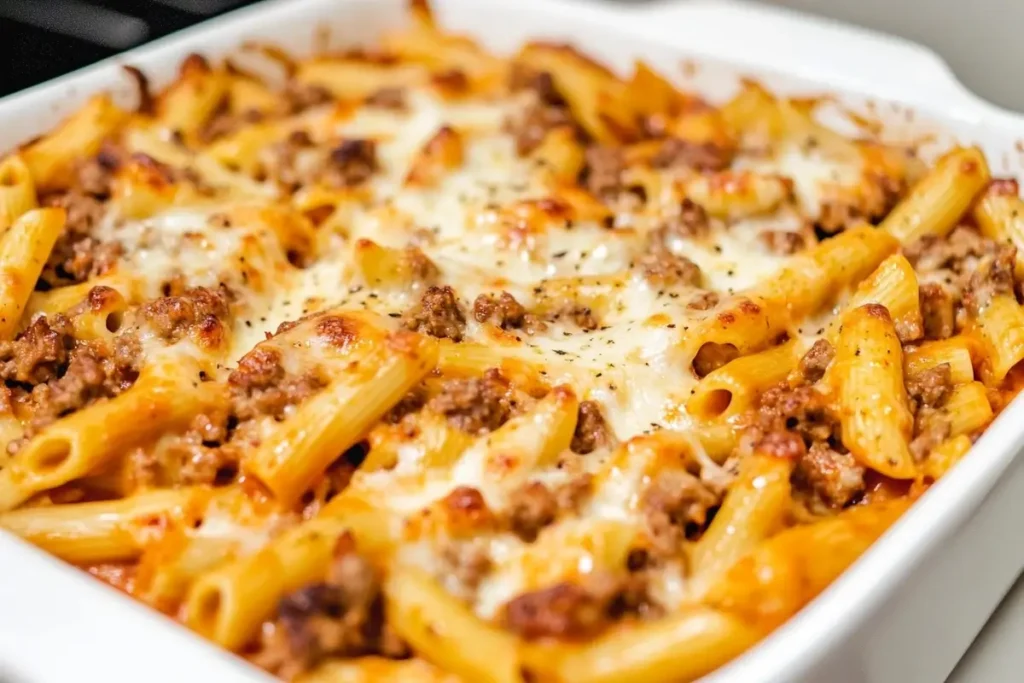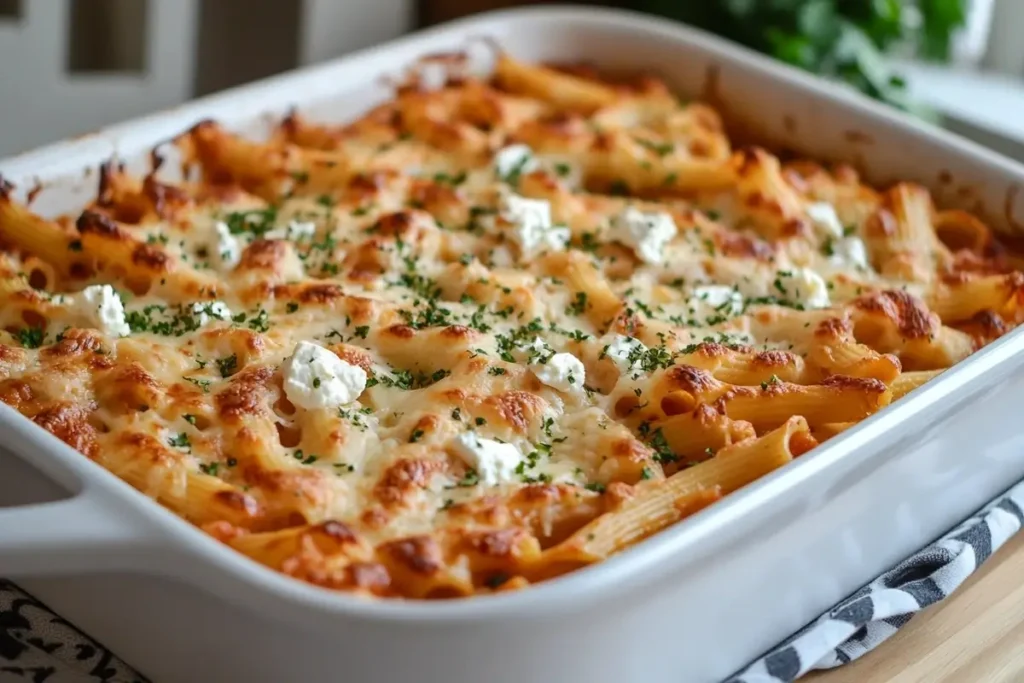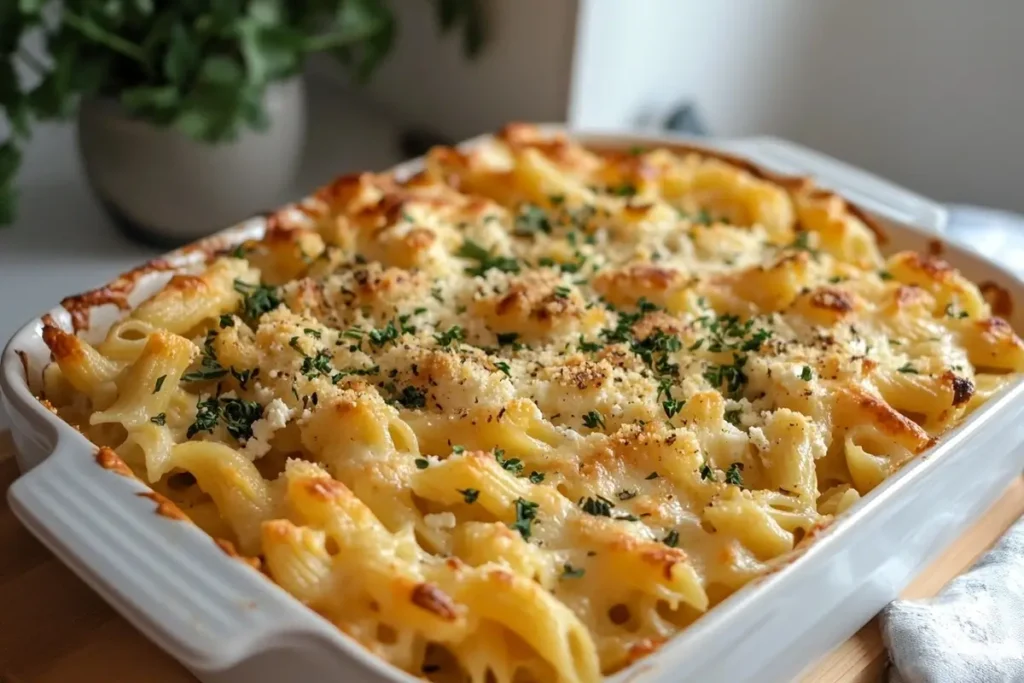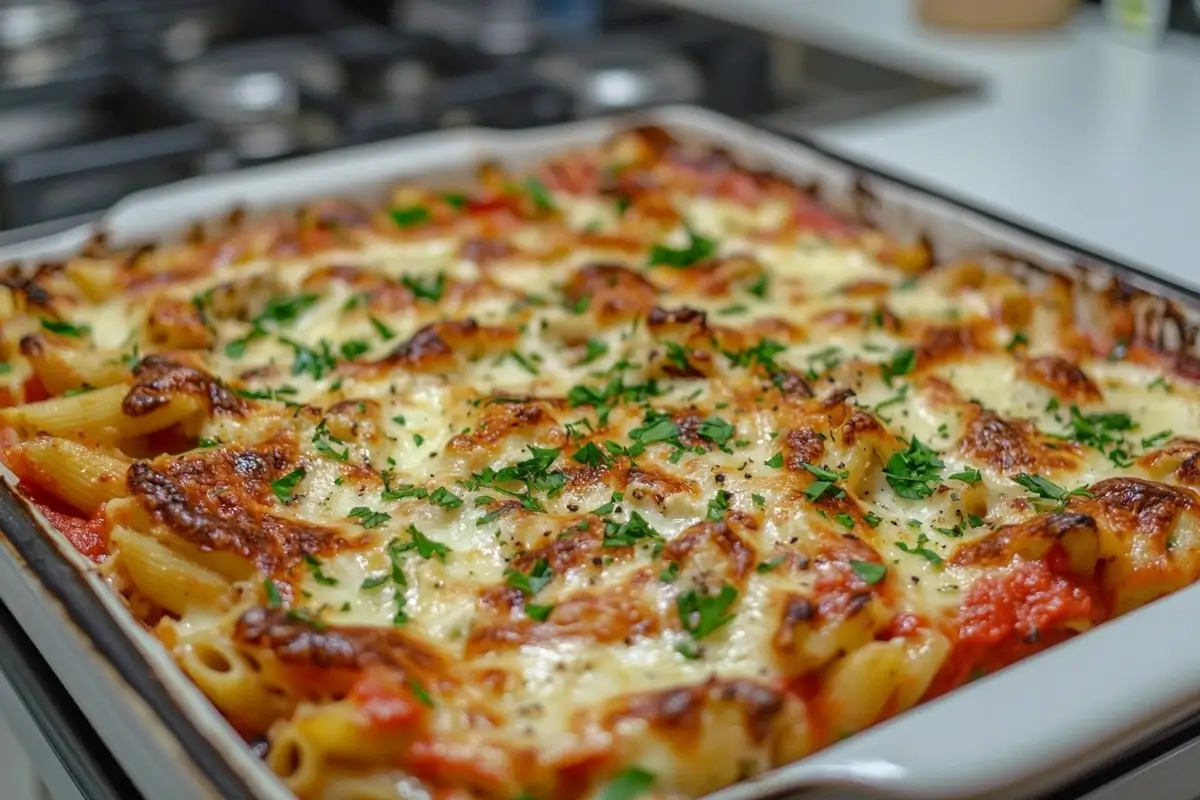Introduction
Can you put feta cheese in pasta bake? Absolutely, and it can elevate your casserole to impressive new heights. Many home cooks shy away from experimenting with feta because they worry about its crumbly texture or tangy flavor. However, feta offers a unique taste that pairs wonderfully with a wide range of ingredients. In this Amazing Ultimate 5 guide, we’ll explore why feta cheese deserves a spot in your next pasta bake, how to incorporate it seamlessly, and what potential pitfalls to watch out for. By the end, you’ll be ready to craft a mouthwatering casserole that’s simple yet striking.
(Image Placeholder 1: alt text “Can you put feta cheese in pasta bake demonstration”)
Feta cheese has a storied history tracing back to Greece, where it has long been celebrated for its briny tang and crumbly consistency. Today, it’s a popular option across the globe, adding instant character to salads, pies, and of course, pasta bakes. But how exactly do you achieve the best flavor blend? We’ll walk through the basics, share cooking tips, and provide inspiring recipe variations that showcase feta’s versatility. Let’s dive in.
Can You Put Feta Cheese in Pasta Bake: The Basics
Feta cheese brings a distinctive tanginess to pasta dishes that can transform an ordinary casserole into something memorable. But what makes feta such a superb choice for pasta bakes? Here are key factors to consider:
- Flavor Profile
Feta is salty, tangy, and slightly sharp, which balances the richness of pasta sauces. It complements both tomato-based and cream-based sauces, ensuring a distinctive taste without overpowering the dish. - Texture
Feta holds its shape better than many cheeses when baked. It won’t fully melt into a gooey pool like mozzarella does, but it softens just enough to distribute flavor throughout each bite. - Versatility
This cheese works with meats like chicken, beef, or sausage. It also pairs beautifully with vegetables such as spinach, tomatoes, bell peppers, and olives. As a result, there’s plenty of room to customize.
Adding feta involves more than sprinkling a few crumbles on top, though. The real magic happens when you fold it into your pasta sauce or layer it throughout your dish. With each forkful, you’ll enjoy tangy bites set against comforting pasta flavors. That contrast is what makes a feta-infused pasta bake so remarkable.

Why Feta Cheese Shines in Pasta Bakes
Feta stands out for several reasons that go beyond taste alone. Understanding these reasons will help you plan a more cohesive dish:
Rich Source of Flavor
Although feta is lower in fat than many cheeses, it still delivers a vibrant flavor punch. You don’t need large quantities to make an impact. A moderate sprinkle or crumble throughout your pasta can significantly enhance taste.
Nutritional Benefits
Feta contains calcium and protein, both of which support healthy bones and muscles. Moreover, it often has fewer calories compared to full-fat hard cheeses. This characteristic can be beneficial if you’re aiming to keep your dish lighter without sacrificing flavor.
Culinary Tradition
Baked feta dishes have long been a staple in Mediterranean cuisine. Greek-inspired pasta bakes often highlight fresh herbs like oregano or basil, robust olives, and juicy tomatoes. Feta fits seamlessly into these traditional flavors, creating a harmonious combination that feels both comforting and exciting.
(Image Placeholder 2: alt text “Fresh feta crumbles”)
Step-by-Step: Creating the Ultimate Feta Pasta Bake
Building a mouthwatering feta pasta bake can be broken down into a few simple steps. The process remains approachable, even if you’re new to cooking. Below is a basic outline you can follow or adapt:
- Choose Your Pasta
Short pasta shapes like penne, rigatoni, or fusilli work exceptionally well. Their ridges and tubes trap sauce and cheese, resulting in flavorful bites. - Select a Sauce
A tomato-based sauce (marinara or passata) highlights feta’s tang and saltiness. Creamy sauces also blend well with feta’s sharper notes. You can experiment to find your favorite mix. - Prep Your Add-Ins
Decide which proteins and vegetables to include. Popular choices are seasoned ground beef, diced chicken, spinach, roasted red peppers, mushrooms, or onions. Pre-cook or sauté these ingredients so they’re partially done before baking. - Assemble the Bake
- Cook pasta until just shy of al dente.
- Combine pasta with sauce, protein, and vegetables in a baking dish.
- Gently fold in crumbled feta to ensure even distribution.
- Top the dish with more feta or add a bit of mozzarella for extra meltiness.
- Bake and Enjoy
- Place the casserole in a preheated oven (around 375°F to 400°F, or 190°C to 200°C).
- Bake for 15–20 minutes, or until the top is lightly browned and bubbly.
- Remove from the oven and let it rest a few minutes to let flavors settle.
In less than an hour, you’ll have a hearty, comforting pasta bake that’s overflowing with tangy, salty goodness. The secret is balancing flavors: ensure your sauce is well-seasoned, and don’t shy away from fresh herbs like oregano, basil, or thyme.
(Image Placeholder 3: alt text “Oven-baked pasta dish with feta cheese”)

Flavor Variations and Customizations
Once you’ve mastered a basic feta pasta bake, you can expand your repertoire by exploring new flavor combinations. The possibilities are nearly endless:
Mediterranean-Inspired
Elevate your pasta bake with olives, artichoke hearts, and a sprinkling of dried oregano. Layer in fresh slices of tomato. The briny flavor of olives works perfectly with the tang of feta.
Creamy Spinach and Feta
Spinach and feta have a long-standing relationship in dishes like spanakopita. Incorporating them into your pasta bake delivers that same earthy, tangy dynamic. Add some ricotta or cream cheese if you prefer an even creamier result.
Spicy Kick
For those who love heat, mix in chili flakes, jalapeños, or hot peppers to balance feta’s bright tang. Top it all off with mozzarella or cheddar for a unique fusion of flavors.
Veggie Extravaganza
Feta’s tangy nature harmonizes with zucchini, eggplant, bell peppers, and onions. Toss these vegetables in olive oil and roast them before adding them to your pasta bake. You’ll get layers of sweet roasted flavor accented by the cheese’s saltiness.
Regardless of the variation you choose, remember to keep the star of the show—feta cheese—in focus. Doing so ensures that your bake remains distinctively tangy and satisfying.
(Image Placeholder 4: alt text “Creamy feta pasta sauce with mixed vegetables”)
Helpful Cooking Tips for Feta Bakes
Even though feta is easy to incorporate, a few practical tips can help you avoid mistakes and elevate your cooking:
- Drain Excess Moisture
If your vegetables release a lot of liquid, drain them to prevent a watery casserole. This step also prevents your feta from losing its pungent taste in a diluted sauce. - Season Wisely
Feta is naturally salty. Taste your sauce before adding more salt. You can always add salt later if necessary. - Use Quality Feta
Not all feta cheeses are created equal. Greek feta made from sheep’s milk typically offers a creamier texture and richer flavor. Look for reputable brands or fresh blocks in brine. - Add Cheese in Layers
Sprinkling feta both within and on top of your dish ensures every bite has a bit of tang. This layering method helps achieve a well-rounded flavor profile. - Don’t Overbake
Cooking your pasta too long can turn it mushy. Likewise, overbaking feta can make it too dry. Pay attention to baking times for the best texture.
Potential Drawbacks of Using Feta
Although feta cheese offers plenty of advantages, it’s wise to consider potential drawbacks:
- Not the Best for a Melty Top:
Feta won’t melt into a uniform layer. If you want a gooey top, combine feta with mozzarella or another melting cheese. - Strong Tangy Flavor:
Some people find feta’s distinct tang overwhelming. Mixing it with milder cheeses like ricotta or cream cheese can tone down the sharpness. - Sodium Content:
Feta can be relatively high in sodium. If you’re watching your salt intake, choose low-sodium versions or rinse the cheese briefly under cold water to reduce saltiness.
Balancing feta with other ingredients can help mitigate these concerns. Ultimately, you can adapt your recipe according to personal preference. The minor trade-offs shouldn’t deter you from enjoying feta’s unique benefits in a pasta bake.
Bringing It All Together: A Sample Feta Pasta Bake Recipe
Below is a simple recipe outline you can follow for a quick, delicious feta pasta bake. Feel free to modify the ingredients based on what you have in your kitchen:
Ingredients
- 1 pound (450 g) short pasta (penne, rigatoni, etc.)
- 2 cups marinara sauce (about 480 ml)
- 1 cup crumbled feta cheese (about 150 g)
- 1 tablespoon olive oil (about 15 ml)
- 1 cup cooked chicken or ground beef (optional)
- 1 cup diced vegetables (such as bell peppers or spinach)
- 1 teaspoon dried oregano
- 1 clove garlic, minced
- Salt and pepper to taste
Instructions
- Preheat the Oven: Set your oven to 375°F (190°C).
- Cook the Pasta: Boil the pasta until it’s slightly undercooked. Drain and set aside.
- Sauté the Vegetables: Warm olive oil in a skillet over medium heat. Add garlic and diced vegetables. Season lightly with salt, pepper, and oregano. Cook until softened.
- Combine Ingredients: Mix pasta, marinara sauce, sautéed vegetables, and optional protein in a large bowl. Gently fold in half the feta cheese.
- Assemble the Bake: Transfer everything to a lightly greased baking dish. Scatter the remaining feta on top for that signature tangy burst.
- Bake: Place in the oven for 15–20 minutes, or until the top is lightly browned. The sauce should be bubbly around the edges.
- Rest & Serve: Let the pasta bake rest for a few minutes before serving to allow the flavors to settle.
With minimal effort, you’ll end up with a hearty meal that’s perfect for a weekday dinner or a potluck gathering. The tanginess of feta, coupled with a savory sauce and any proteins or veggies you choose, creates a balanced dish that’s guaranteed to please.

Additional Serving Suggestions
Consider these complementary sides and garnishes to round out your pasta bake meal:
- Garlic Bread: The crunchy, buttery texture is a lovely contrast to the soft pasta.
- Greek Salad: Amp up the Mediterranean theme with cucumbers, olives, tomatoes, and extra feta crumbles.
- Herb Garnishes: Fresh basil, parsley, or dill can add a final flourish.
Furthermore, a glass of crisp white wine can enhance the tang of feta, making your meal feel like a mini vacation in a Mediterranean setting.
FAQ
Will feta melt in pasta?
Feta cheese softens but does not fully melt in pasta. It retains a crumbly texture that becomes creamy when heated. This characteristic adds little bursts of tangy flavor throughout the dish. If you want a gooey cheese topping, pair feta with a melting cheese like mozzarella.
Is feta cheese good in pasta?
Yes, feta cheese is excellent in pasta. Its briny, tangy flavor balances rich sauces, making each bite more interesting. Feta can be used in both tomato-based and creamy sauces. It also pairs well with vegetables like spinach, tomatoes, and olives for a complete, flavorful meal.
Does feta cheese melt when baked?
Feta cheese will not melt into a uniform, gooey layer when baked. However, it softens enough to blend with your other ingredients. The result is a pleasantly creamy texture with distinct tangy pockets of cheese. For a more traditional cheese pull, consider mixing in mozzarella or another melty cheese on top.
Can I cook feta in pasta?
Absolutely. Cooking feta in pasta is a simple way to add depth to your dish. You can fold feta into a sauce, crumble it over the top, or layer it within a pasta bake. When heated, it infuses the pasta with a tangy, savory essence that complements many types of sauces and vegetables.

